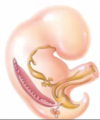Urogenital Anatomy Flashcards
1
Q
How do primary sexual characteristics develop in males and females?
A
- all of the primary sexual characteristics (internal and external organs of reproduction) develop from the same starting point in males and females
- all of these organs have homologs in both sexes
- renal and reproductive development are intertwined
2
Q
Describe development of XX genotype
A
- cortex (pink) of the indifferent gonad develops
- perimesonephric duct stays attached to it and descends into the pelvis to become the ovary
- mesonephric kidney and mesonephric duct system mainly disappears

3
Q
Describe the development of the XX genotype with the kidney
A
- the cortex of the indifferent gonad develops and stays attached to the perimesonephric tube, mesonephric kidney and duct mostly disappear
- develop a metanephric kidney; a branch off of the mesonephric duct connects to the developing metanephric kidney which ascends in the body wall while the gonad descends

4
Q
What are the homologs between males and females?
A
- ovary and testes
- clitoris and erectile tissue of corpus cavernosum
- glans of penis is homologous to glans of clitoris
- round ligament and remains of the gubernaculum
- scrotum and labium majora
5
Q
Identify structures

A

6
Q
Describe the path of the ureter
A
- travels along the posterior body wall behind the peritoneum
- ureteropelvic junction is the first narrowing of the ureter
- crosses over the psoas and iliacus muscles and external iliac artery
- ureterovesicular junction is narrowing as the ureter enters the bladder
- kidney can make stones in the pelvis and they get trapped at these points along the path

7
Q
What occurs if the ureter gets blocked at the ureteropelvic junction?
A
- hydronephrosis
- build up fluid and pressure back into kidney causing renal pelvis to expand
- influences the ability of the kidney to make urine
8
Q
What could occur with a blockage of the ureter at the iliacus/psoas muscles and external carotid?
A
- hydronephrosis and hydroureter
- greatly expanded ureter
- urine is produced so the ureter is expanded

9
Q
Describe the muscle of the ureter
A
- longitudinal layer of muscle closest to the lumen of the ureter
- circular layer of smooth muscle on the outside
10
Q
What function does the mucosal lining of the ureter serve?
A
- mucus makes it harder for bacteria to adhere to the epithelium
- protects from ascending bacteria/viruses from the bladder infecting the ureter
11
Q

A

12
Q

A

13
Q

A
- sacroiliac is a gliding joint
- sacrococcygeal joint doesn’t move much except in childbirth it moves coccyx out of the way
-

14
Q
How do the pelvic joints change during gestation?
A
- in the last 3 months of gestation, the joints relax remarkably
- movement of the SI joint when the woman is in dorsal lithotomy position may increase pelvic diamter 1.5-2cm
- not necessarily the best position to labour in as it compresses blood vessels around pelvis and can compromise venous return

15
Q
Contrast the gynecoid and android pelvis
A
- gynecoid is light and thin, android is thick and heavy
- gynecoid has shallow false pelvis (area bound between ischiums and towards pubic symphysis), android has deep cup shaped false pelvis
- gynecoid true pelvis is large and slightly oval pelvic brim, android is small heart shaped pelvic brim
- pubic arch is greater than 90 degrees in gynecoid, android pubic arch is less than 90 degrees
- coccyx angled toward anterior in gynecoid, angled strongly toward anterior in android
- anterior area in male pelvis is much larger which is indicative of its not round shape



























